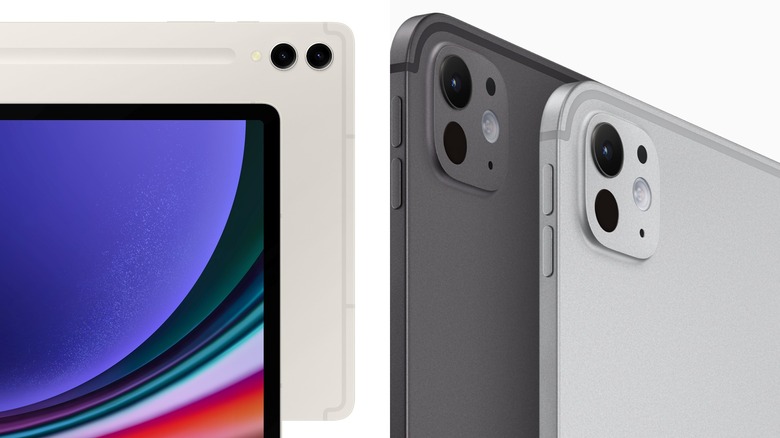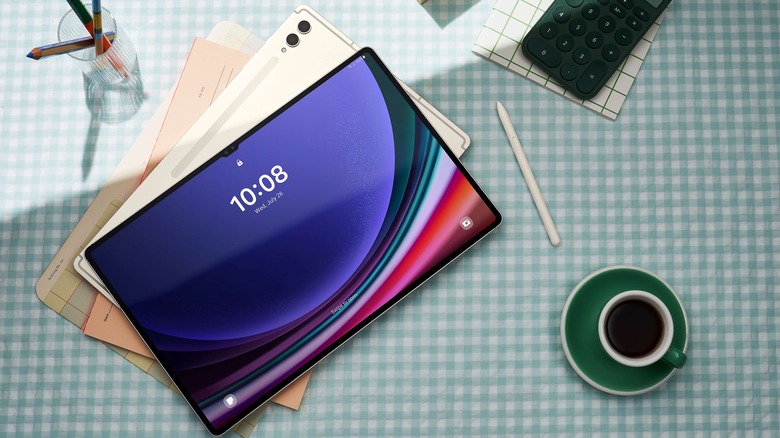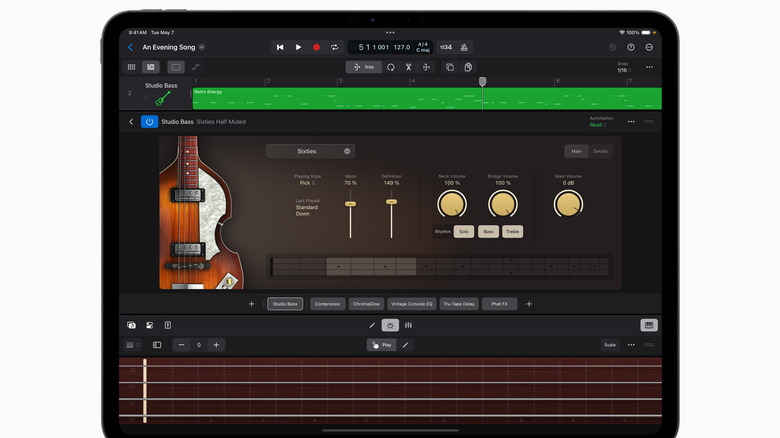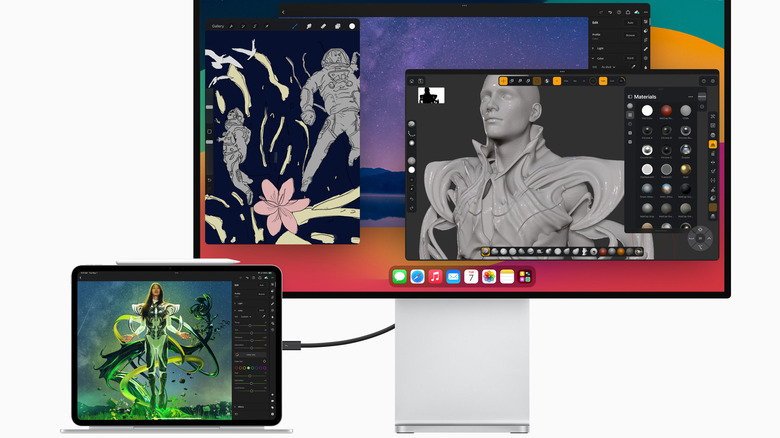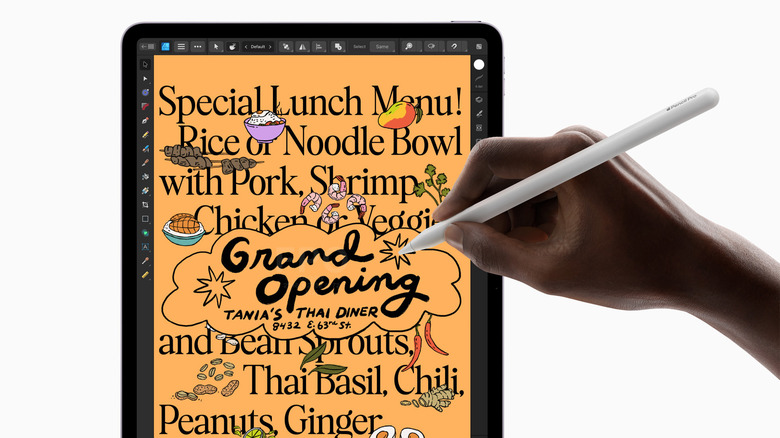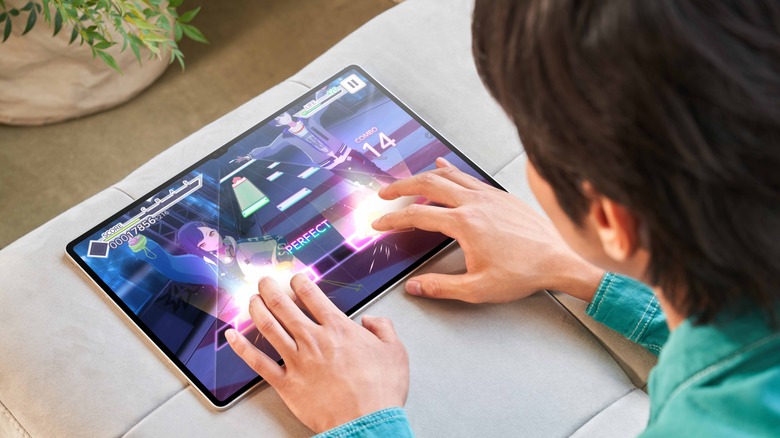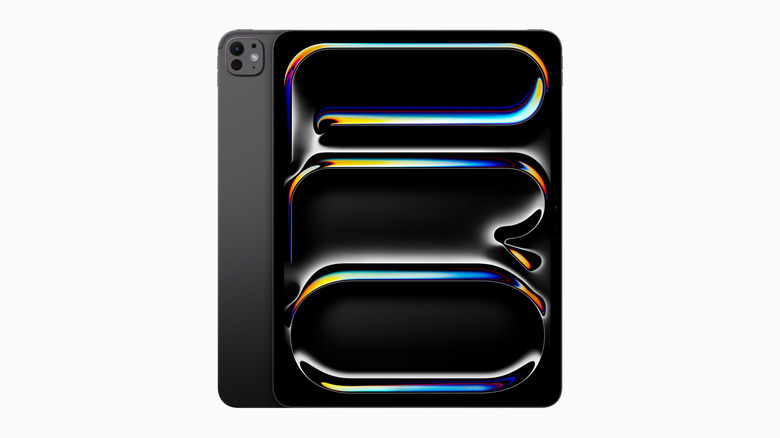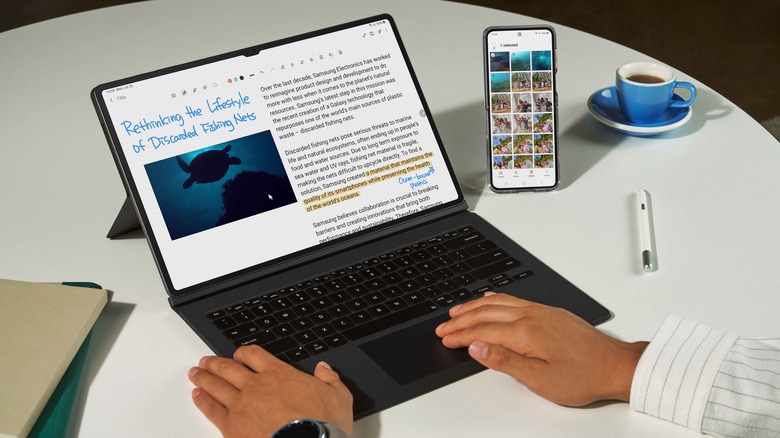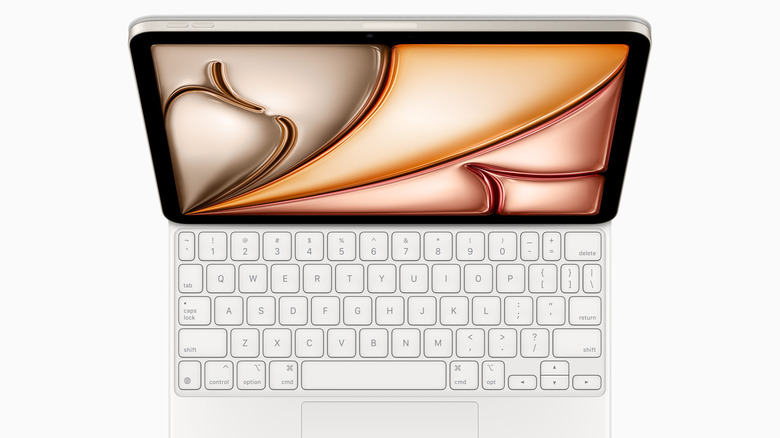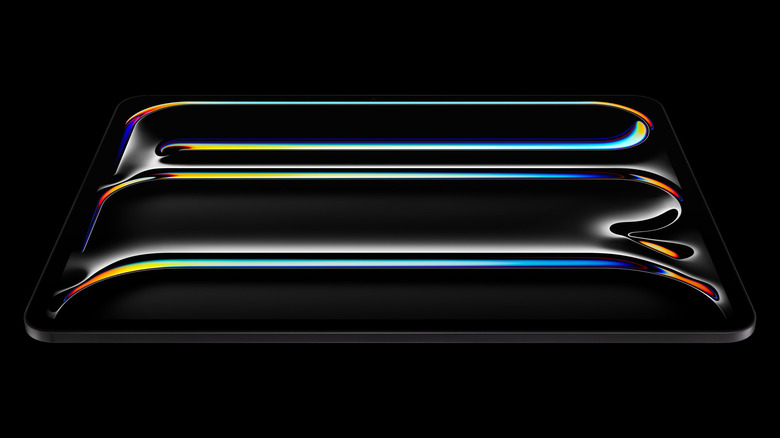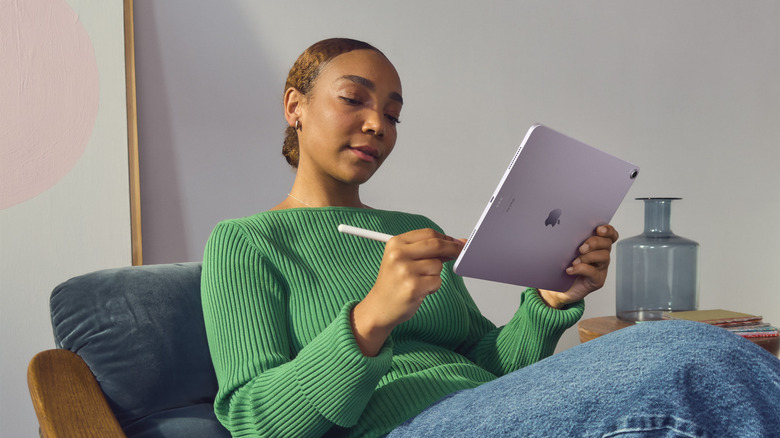iPad Vs. Android Tablets: Which One Should You Choose In 2024?
Tablets have occupied a place in our every day, digital lives for over a decade, but it's hard to argue the dominance of the iPad. In Q4 of 2023, Apple's tablet shipments represented 40% of worldwide sales, while the other top four Android tablet manufacturers combined amounted to just under 39%. But while those numbers tell a story, do consumer choices tell the full tale, or are Android tablets better than their sales volumes imply?
While Apple keeps pushing the boundaries of what can even be called a tablet, equipping their top-end iPads with the latest, desktop-class M-series chips, the iPad's software experience hasn't changed all that much over the years, except some extra multitasking features large enough to warrant splitting the tablet version of iOS into its own operating system called iPadOS. Meanwhile, although the tablet version of Android remains mostly the same as the phone version, manufacturers like Google and Samsung have added things like taskbars and more robust split-screening to their tablets.
So, which tablet offers the best bang for your buck in 2024? Spoiler: the answer depends on who you are and what you plan on using a tablet for. But to help you understand the differences between devices, we'll break down each ecosystem's offerings by performance, app selection, features, price, and more.
What we're actually comparing
The problem with comparing Apple's iPad lineup to Android tablets is that the latter can be too broad. Apple is a single company with a (relatively) simple tablet lineup, whereas many companies manufacture Android tablets of varying price, performance, and flavor. As an illustrative example, Google's latest Pixel Tablet is a much different experience than Samsung's latest Galaxy Tab S9 Ultra, because the Pixel Tablet is a midrange device that costs $400, while the Tab S9 Ultra is a high-end computer replacement that costs an eye-watering $1600 if you max out its specs. While the iPad does range in price from $349 for the base model with the lowest storage capacity to a stunning $3,077 for the top-spec 2024 iPad Pro, its feature set and user experience are nearly identical, with the main differences being in screen quality and performance.
For that reason, we're comparing Apple's entire iPad lineup to the tablet offerings from the most prominent Android manufacturers, namely Samsung, Google, OnePlus, and Lenovo. These companies manufacture the tablets you're most likely to find at your local Best Buy or other big box tech store, which makes their products the fairest comparison to the iPad with the broadest consumer appeal. For the same reason, we're not comparing iPads to hobbyist, enthusiast, or niche Android tablets. Fascinating though they may be, those devices do not fill the same consumer need as a standard tablet. For this comparison, an iPad Pro (2022) was pitted against a Samsung Galaxy Tab S9 Ultra for intensive testing. Here's how those comparisons shook out.
How do they perform?
Look, there's no sugarcoating it: Apple's iPad lineups simply blow Android competition out of the water when it comes to performance. The latest iPad Air has Apple's desktop-class M2 chip inside, while the extremely thin iPad Pro has the M4, which hasn't even made it into a Mac yet. Considering that the very best Android tablet, the Samsung Galaxy Tab S9 Ultra, is still rocking last year's top-end smartphone chip, the Snapdragon 8 Gen 2, there's really no competition here. Even the cheapest iPad, which costs $349 still outperforms the majority of Android tablets in its price range.
However, raw specs aren't the whole story. Yes, the iPad excels at intensive tasks like gaming and video editing, but outside of certain applications, Apple has thus far deigned to unlock a lot of the capabilities afforded to the iPad by its beefy spec sheet. There's no full desktop mode with windowed apps like you'll find on Samsung's most affordable tablet, nor can you run the kind of professional software on a seventh-generation iPad Pro that you can on a MacBook. All that horsepower under the hood doesn't translate to real-world use.
Even so, it's undeniable that if performance is what's most important to you, the latest iPad Air and iPad Pro are hands down the best-performing tablets on the market, tearing up benchmarks against the best Android tablets. The only devices that give them a run for their processing power are Windows PCs crammed into tablet form factors such as the ASUS ROG Flow Z13. If you're after pure computing power, you might be better off with one of those than an iPad Pro since it can run games and professional software, but we're getting outside the scope of this article with that comparison.
How is the ecosystem?
If you know anything about Apple products, you probably know how well they all work together. That applies just as much to the iPad as anything else made by the Cupertino giant, but you might not know that Microsoft has been working together to make Android and Windows work as a pair. So, which ecosystem provides the most functionality?
If you already own a Windows laptop or desktop, you may find Microsoft's Phone Link useful in tandem with an Android tablet. You can copy/paste between devices, open tablet apps on your PC, and even drag/drop files between the two devices. It's worth noting that this system works best with Samsung devices — majority of those officially supported. Android devices also play well with one another, with features like Quick Share letting you send files between your phone, tablet, and desktop.
On the other side of the aisle, adding an iPad to your Apple ecosystem, you'll get an even more deeply integrated experience. You can continue conversations in iMessage across devices, take FaceTime calls, and sync content. There's AirDrop, Sidecar, Universal Control, Handoff, and dozens of other ways your Apple products can handshake.
For those who already own other Apple products, the interconnectedness of the ecosystem may be enough reason to choose an iPad, all else aside, whereas those who live an Apple-free life may find that an Android tablet satisfies their needs better. If you own a mix of both Apple and non-Apple devices, the win here still goes to the iPad, since you'll enjoy its ecosystem benefits.
What apps are available?
No matter which tablet you buy, it's ultimately only as useful as the apps it can access. Without third-party apps, your fancy new iPad or Android tablet is nothing but an expensive slab. App selection is an advantage the iPad has long enjoyed over its Android-powered competitors, but the tides are turning.
While Android's tablet app selection has grown over the years, it remains leaner compared to what's available in the App Store on iPadOS. The iPad is well-known for the wide range of creative apps it has access to, which has attracted many visual artists, musicians, writers, and other creative types to its ecosystem. Those apps are plentiful on iPadOS, and some of the most popular apps for artists, like Procreate, are not available on Android. Others, though available, are not optimized, and something you want to avoid on your Android Tablet. Luckily, there are browser-based alternatives for many apps.
However, things are starting to look up for Android apps. At time of this writing, most of the most common apps that most people will use most have a robust tablet experience. Meanwhile, apps that were previously exclusive to the iPad, such as Good Notes for stylus-based handwritten notes and LumaFusion for robust video editing, are now available on Android tablets. Another Android benefit is the ability to sideload apps. While Apple is recently being made to support third-party app stores in certain regions, Android has always embraced apps from alternative sources, meaning you can get apps that aren't available in the Google Play Store, because they violate the rules or, like Epic Games and "Fortnite," rely on sideloading as a distribution model.
Do you use it for gaming?
Speaking of popular games like "Fortnite," it's worth examining the difference in gaming capabilities between iPad and Android tablets. As mentioned in our comparison of app selections, Android is a more open platform than iPadOS, which means that developers who don't want to deal with the restrictions imposed by the Google Play Store can simply distribute apps for direct download, much like software on a traditional PC.
When it comes to games, Apple strictly protects its walled garden, which has led to more than a few of the most popular titles being removed from the App Store. "Fortnite" is a prime example. Without going into laborious detail, Epic Games isn't on good terms with either Apple or Google, so "Fortnite" isn't available on either company's app marketplace. But while Android users can download the game directly from Epic, iPadOS and iOS users are out of luck. The same concept applies to other gaming applications. For example, Nvidia's Geforce Now game streaming service has a native Android app available in the Play Store, while those on iPadOS will need to launch it from the Safari browser instead, resulting in a less robust experience. The same goes for Xbox Game Pass and other streaming solutions with the exception of PS Remote Play.
Still, the iPad has a rather robust library of games. Apple Arcade adds a decent selection of titles, though mostly mobile ones. And Apple is lately adding AAA titles like "Resident Evil 4" on its tablets. But Android wins this round for its expanded access unrestricted by app marketplaces.
How is the user experience?
Another important aspect that may influence your tablet choice is the user experience. How much friction will you encounter in day-to-day use, and how pleasant will the experience be overall? When it comes to making a pleasing user experience, Apple is well versed, and the iPad is no exception to the seamless experience Apple users have come to expect. Apps are generally fluid and modern-looking, while the overall experience of navigating iPadOS is fluid and intuitive in most situations.
The experience of using an Android tablet is less polished in most cases. While they're not the majority, you're more likely to encounter apps that haven't been updated in many years, leaving them with an out-of-date look that can be confusing from a user experience perspective and visually unappealing. Other apps that aren't optimized for large screens look empty when stretched to tablet proportions, and their phone-centric interfaces can be aggravating to use on a larger scale. Additionally, there are more likely to be confusing menus and hidden settings on Android that may deter those who don't want to spend a lot of time learning the ins and outs of their devices. However, those rougher qualities mean a more customizable experience.
You can customize every aspect of an Android device, and tablets are no exception. Plus, while the iPad forces power users to wear kiddie gloves when it comes to things like file management, Android works more like a traditional computer, allowing full file access and app sideloading from the Internet. The inability to do these things on the iPad is not because any iPad is incapable of doing so, but because Apple has decided for its users that they are not allowed to use it like a real computer.
What features do they have?
Because Android is fragmented into so many different manufacturers, there are, overall, lots more features available to consumers than those in the iPad range. However, you're not going to buy every Android tablet — you're buying one. The unifying features across all major Android tablets are those offered by the core Android operating system. Other manufacturers add their features atop specific platforms, which is a good or bad thing depending on how useful or intrusive those features are for your needs. Still, Android does have the feature advantage overall.
On iPad, there is the ecosystem covered in the previous section, along with multitasking features like Split View, Slide Over, and Stage Manager. But the iPadOS experience is largely designed to facilitate apps, which makes up the bulk of the user experience. Meanwhile, Android also offers robust split screen and multitasking modes, especially on Samsung's range of Tab S tablets, which can open unlimited apps in windows like a computer desktop and can emulate a desktop further with Samsung's built-in DeX mode. Both support styli and external storage, while some Android tablets include SD card slots for permanent external storage without sacrificing a USB port. And, of course, Android is the more customizable OS, supporting deep levels of UI customization.
A rising chorus of iPad users and tech journalists have been begging Apple to make a version of iPadOS that does justice to the incredible hardware on the newest iPads. It doesn't make much sense that an Android tablet with a mobile processor can be a better laptop replacement than an M4 iPad Pro, but that's the world we live in. Apple may announce new iPad features at WWDC in June, but right now, Android wins this round.
What about accessories?
While some people buy a tablet to have an extra screen for Netflix, YouTube, and web browsing, power users know that it's hard to get the most out of a tablet without accessories. Cases with kickstands will let you prop your tablet on a desk or table while keyboards can make productivity work a lot easier, and USB accessories can help you turn that glass slab into a laptop replacement.
Apple has long provided a robust range of accessories from the iPad. Most notable is the Magic Keyboard, which has received plenty of praise over the years for its sleek design and functionality. Then there's the Apple Pencil, which despite having a confusing array of options is often lauded by those who use the iPad for visual art or handwritten notes and was recently released in a Pro variant. However, Apple's accessories are rather expensive. $349 for the new Magic Keyboard is a hard number to swallow, and $129 for the Pencil Pro is a lot to fork over for a stylus. Thankfully, Apple also enjoys a robust third-party accessory ecosystem, with brands from Logitech to Dbrand making accessories every iPad user should have.
Things are a bit leaner on the Android side. Thanks to the fragmentation of the Android tablet market, there's no singularly dominant tablet that accessory manufacturers can invest in designs for, so most opt not to release accessories for products that won't see widespread adoption. It's often up to the tablet manufacturers themselves to produce accessories for their products, and some are better about doing so than others. Samsung, for example, makes a broad range of keyboard cases and screen covers for its Galaxy Tab S line, but they're just as expensive as Apple's.
How about price?
Apple has a reputation for charging alarming sums of money for its gadgets, and the iPad is no exception. At the top end, an iPad Pro (2024) with all available upgrades, an Apple Pencil Pro, and a Magic Keyboard, will run you an eye-watering $3,077, the equivalent of a month's rent in Manhattan. Meanwhile, the most expensive Android tablet, the Samsung Galaxy Tab S9 Ultra, costs $1,750 when bundled with its own proprietary keyboard case. Thankfully, the Galaxy comes with a stylus in the box that gives the Apple Pencil Pro a run for its money and tips the price in its favor.
Of course, you don't have to spring for Apple's top-end iPad. At the low end, the iPad 10th Generation costs a mere $350 for the lowest spec option, which is truly a great price, even if you're leaving the M series chips behind for an A14 Bionic chip. Spend a similar amount on an Android tablet from Lenovo and you're getting a pretty mediocre experience with a MediaTek Dimensity 7050 processor. To its credit, Apple has ensured that there's an iPad for every budget.
However, even though Apple's 2024 iPad pricing appeals to most people, the fact remains that the top of its price range is far beyond Android's, and for that reason, Android tablets have more bang for buck at the high end, while Apple has a better value at the low end. In other words, if you want nothing but the best, you should look at both operating systems, whereas if you just want a tablet you can leave sitting around in the living room and want to save some money, you should start your search with the entry level iPad.
Conclusion: if you come for the iPad, you'd better not miss
While both Android and iPadOS have their major strengths and weaknesses, an iPad of one variety or another will be the best tablet for most people. The combination of fluid software, industry leading hardware, and user experience — especially for those already in Apple's walled garden ecosystem — all curated by a single entity in Apple is a winning combination that the fragmented Android market can't compete with. In addition, the iPad is better supported with first- and third-party accessories, and there's a version of it available at a variety of price points from high to low. However, that doesn't mean there's no place for Android tablets.
Despite the iPad's lead in certain areas, there are those for whom an Android tablet will be more useful than an iPad. Those who don't own any other Apple products may find the iPad hard to integrate into their digital lives, and those who love customizing every aspect of a device will find Android more freeing in that regard. Additionally, those who want to do things like stream games, sideload apps, and more generally have freedom over their own experience rather than have that experience dictated by the manufacturer will be happier with an Android tablet.
Methodology
This comparison was written following a week of testing with both an Apple iPad Pro (2022) and a Samsung Galaxy Tab S9 Ultra to ensure that both operating systems were running on the most capable hardware to show their strengths (a 2024 iPad Pro could not be procured in time for publication). Both devices were used for a range of entertainment, gaming, artistic, and productivity tasks including video streaming, gaming from local and streamed sources, visual art, and document editing. The iPad was used in concert with a Magic Keyboard and Apple Pencil stylus, while the Galaxy Tab was used in conjunction with a Keyboard Case Slim and the included S Pen stylus.
